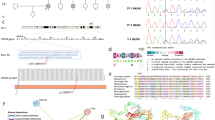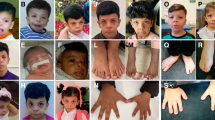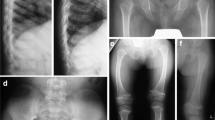Abstract
Hajdu-Cheney syndrome is a rare autosomal dominant skeletal disorder with facial anomalies, osteoporosis and acro-osteolysis. We sequenced the exomes of six unrelated individuals with this syndrome and identified heterozygous nonsense and frameshift mutations in NOTCH2 in five of them. All mutations cluster to the last coding exon of the gene, suggesting that the mutant mRNA products escape nonsense-mediated decay and that the resulting truncated NOTCH2 proteins act in a gain-of-function manner.

Similar content being viewed by others
Accession codes
References
Brennan, A.M. & Pauli, R.M. Am. J. Med. Genet. 100, 292–310 (2001).
Kopan, R. & Ilagan, M.X. Cell 137, 216–233 (2009).
Holbrook, J.A., Neu-Yilik, G., Hentze, M.W. & Kulozik, A.E. Nat. Genet. 36, 801–808 (2004).
Li, L. et al. Nat. Genet. 16, 243–251 (1997).
McDaniell, R. et al. Am. J. Hum. Genet. 79, 169–173 (2006).
Weng, A.P. et al. Science 306, 269–271 (2004).
Lee, S.Y. et al. Cancer Sci. 100, 920–926 (2009).
McCright, B. et al. Development 128, 491–502 (2001).
Hilton, M.J. et al. Nat. Med. 14, 306–314 (2008).
Engin, F. et al. Nat. Med. 14, 299–305 (2008).
Zanotti, S. et al. Endocrinology 149, 3890–3899 (2008).
Fukushima, H. et al. Mol. Cell. Biol. 28, 6402–6412 (2008).
Kung, A.W. et al. Am. J. Hum. Genet. 86, 229–239 (2010).
Bales, C.B. et al. J. Pediatr. Gastroenterol. Nutr. 51, 66–70 (2010).
Wu, Y. et al. Nature 464, 1052–1057 (2010).
Acknowledgements
We are grateful to the affected subjects and their families who participated in this study. We thank F. Gros, H. Eldjouzi, A. Briand, C. Beneteau and S. Lecointe for technical assistance, and R. Houlgatte and C. Chevalier from Biogenouest de Nantes. This research was funded by grants from Inserm, Fondation pour la Recherche Médicale, Fédération Française de Cardiologie and Région Pays-de-la-Loire. P.L. is supported by the Direction Hospitalière de l'Organisation des Soins (DHOS). S.J. is funded by the “bourse de relève acadèmique de la Facultè de Biologie et Mèdecine de l'Université de Lausanne.”
Author information
Authors and Affiliations
Contributions
C.L.C., B.I., S.B., V.C.-D., L.F. and A.D. conceived the project and planned the experiments. B.I., V.C.-D., L.F., M.L.M., S.J., D.M.-C., C.T.-R. and A.D. clinically characterized the HCS cases and collected blood samples. O.P. performed validation experiments. P.L., C.D., R.R., B.I., J.-L.M. and C.L.C. analyzed and interpreted the exome data. C.L.C., B.I., R.R., J.-L.M. and S.J. wrote the manuscript. All authors contributed to the final manuscript.
Corresponding author
Ethics declarations
Competing interests
The authors declare no competing financial interests.
Supplementary information
Supplementary Text and Figures
Supplementary Tables 1–5, Supplementary Figures 1–3 and Supplementary Methods. (PDF 465 kb)
Rights and permissions
About this article
Cite this article
Isidor, B., Lindenbaum, P., Pichon, O. et al. Truncating mutations in the last exon of NOTCH2 cause a rare skeletal disorder with osteoporosis. Nat Genet 43, 306–308 (2011). https://doi.org/10.1038/ng.778
Received:
Accepted:
Published:
Issue Date:
DOI: https://doi.org/10.1038/ng.778
- Springer Nature America, Inc.
This article is cited by
-
Clinical relevance of targeted exome sequencing in patients with rare syndromic short stature
Orphanet Journal of Rare Diseases (2021)
-
Cortical bone development, maintenance and porosity: genetic alterations in humans and mice influencing chondrocytes, osteoclasts, osteoblasts and osteocytes
Cellular and Molecular Life Sciences (2021)
-
Distinct severity of phenotype in Hajdu-Cheney syndrome: a case report and literature review
BMC Musculoskeletal Disorders (2020)
-
Increased diagnostic and new genes identification outcome using research reanalysis of singleton exome sequencing
European Journal of Human Genetics (2019)
-
Bisphosphonate therapy for spinal osteoporosis in Hajdu-Cheney syndrome – new data and literature review
Orphanet Journal of Rare Diseases (2018)





